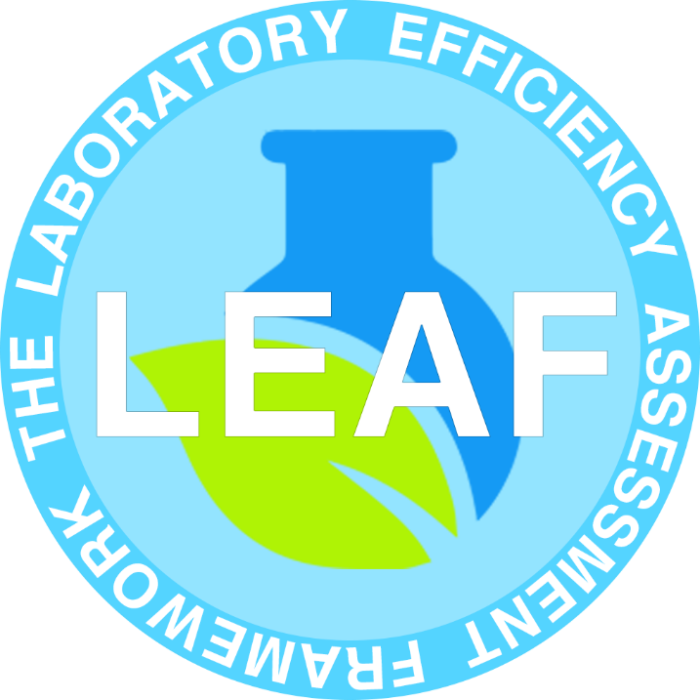First LEAF Silver Certificate at the University

The Protein Production Facility receives the first LEAF Silver Certificate at the University.
Laura Wilkinson Hewitt is a Staff Sustainability Architect in the Faculty of Biological Sciences and, in her role as a Research Technician in the Protein Production Facility, has introduced new sustainable practices into the Facility. The Facility is now the first laboratory at the University to receive the LEAF Silver Certificate. Laura's actions contributed to the University's #2023PlasticPledge by switching to FSC certified paper weighing boats, glass Petri dishes, and a lot more. These changes will save around 5,000 pieces of single use plastic per year.
Are you a researcher looking for ways how to make your labs more sustainable? Would you like to drive behaviour change in your environment by setting an example for fellow labs? Or if you simply want to discover what LEAF is, then keep reading.
LEAF (The Laboratory Efficiency Assessment Framework) is a standard developed by University College London, which helps researchers, staff and students to improve the sustainability and efficiency of their labs. This efficiency is achieved by deploying a variety of sustainable practices and quantifying your impact in financial and carbon savings. Labs can be awarded a bronze, silver or gold certificate based on the number and level of sustainability actions taken.
Laura has shared her thoughts on LEAF and given some advice on how to successfully deploy sustainable practices in your labs.
What are some of the practices you implemented on the LEAF Silver Level?
The LEAF Silver accreditation includes all 16 Bronze measures plus another 17, so 33 in total. One point is to assess and reduce consumable use, targeting single-use plastic if possible. I have already done a lot of work reducing the single-use plastic waste in my lab so that one didn’t require much extra work on my part. A lot of the criteria are about making lab users aware of things: sustainable water use, the most economical way to use equipment such as fume hoods, the 12 principles of green chemistry, plus adding sustainability into lab inductions. All very simple yet effective ways to make all lab users aware of how to do more sustainable science.
What were the main obstacles and how did you overcome these?
Because I took the lead on this, I didn’t really meet any obstacles from other colleagues; I’ve had brilliant support from the facility manager to implement any changes. I think in the future there may be obstacles to overcome with regard to continuity – if I change roles for example, will people carry on with the changes I’ve made? I’ll try to make it as easy as possible for people to do this by recording everything and embedding the changes in our handbook and inductions.
My advice to other labs wanting to implement LEAF would be to get as many people in your research group on board. Most of the changes are small things that over time will make a big difference, though some of them do add to the general housekeeping jobs – putting in place a system to keep freezers free from old samples and regularly defrosting them, cleaning the filters on freezers and incubators regularly, changing plastic consumables for reusable alternatives which clearly creates more washing up. But, if everyone contributes to these changes, the actual workload increase for each individual is very small, and the benefits are great.
What’s the benefit of implementing these practices in the labs?
The LEAF programme has helped reduce carbon emissions and save money and energy for dozens of institutions and organisations, in the UK and across the world. Mostly, I think the LEAF programme makes scientists aware of what kind of things equal sustainability, and it catalyses behavioural change. It’s not just about using less energy and fewer pieces of plastic – it’s about producing repeatable science, spreading awareness, improving communication, and increasing collaboration.
Where would you like to see your labs in the future? How do you imagine them?
Our aim to get every one of the FBS Research Facilities signed up to LEAF and at least Bronze certified in the next few months. I would love to see all our university labs net zero and single-use plastic free, but I feel that may be a bit of an ambitious dream! Reducing our energy use and carbon footprint as much as possible would be great, and if we can invest in carbon insetting and offsetting measures to help reach carbon neutrality it would be amazing. With regards to plastic and waste – traditionally labs used glass instead of plastic, and although it creates a lot of washing up, if we could get back to using glass as the norm again that would be a huge step in the right direction. I’d love to see science being performed in a sustainable way as standard, integrated into every protocol and becoming habit. The undergraduate and PhD students of today are the research group leaders of the future – if they learn to do science in a more sustainable way, they will go on to share their knowledge with the scientists they train, and it will simply become the way things are done.
Inspired by Laura's success and want to follow her lead? Find out more about Sustainable Labs or becoming a Staff Sustainability Architect.
We use the United Nations Sustainable Development Goals (SDGs) as a framework to guide our activity. Our sustainable labs work is linked to the following SDGs:
- Goal 7: Affordable and clean energy
- Goal 9: Industry, innovation and infrastructure
- Goal 12: Responsible consumption and production
Find out more about our impact on the SDGs.
